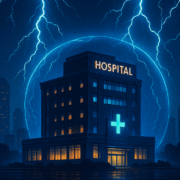Certified Lightning Protection Installer – Protect Your Home
Last summer, a Tampa family narrowly avoided disaster when a powerful storm sent a fiery bolt crashing into their backyard oak tree. The strike traveled through their home’s wiring, frying appliances and sparking a small attic fire. While they were unharmed, the incident highlighted a harsh truth: nature’s unpredictability demands proactive safeguards.
Modern homes face growing risks from severe weather, with electrical surges and structural damage costing homeowners thousands annually. Many insurers now require specialized safety measures for properties in high-risk areas, including commercial buildings, schools, and residential neighborhoods. This shift reflects the proven value of advanced defense systems in reducing fire hazards and equipment failures.
Our team brings decades of combined expertise to every project, ensuring solutions meet strict industry standards. From initial site evaluations to tailored designs, we focus on long-term safety and compliance. Regular maintenance checks further guarantee system reliability year after year.
Don’t wait for disaster to strike. Call us today at (813) 630-2757 for a no-obligation assessment. Let’s secure what matters most—your family’s safety and peace of mind.
Expert Services by a Certified Lightning Protection Installer
In an era where weather patterns grow increasingly volatile, property safeguards demand specialized knowledge. Our team combines cutting-edge training with rigorous adherence to national safety benchmarks, delivering solutions that stand up to nature’s fiercest challenges.
Our Team’s Certification and Expertise
Every specialist holds credentials from the Lightning Protection Institute and maintains active UL certification. These qualifications ensure installations meet strict guidelines for structural coverage and surge prevention. Regular updates to our training programs keep skills sharp with the latest techniques in risk assessment and equipment placement.
Third-party inspections form a critical part of our process. Independent evaluators verify system integrity, confirming compliance with NFPA 780 standards. This dual-layer validation gives clients peace of mind knowing their safeguards perform as intended during severe storms.
Call Us for Expert Guidance At (813) 630-2757
Whether upgrading existing systems or designing new defenses, our professionals tailor approaches to your property’s unique layout. Commercial complexes and historic homes alike benefit from customized strategies that address specific vulnerability points.
Connect with our specialists today at (813) 630-2757 for a detailed evaluation. We’ll explain how advanced safety measures can shield your assets while potentially lowering insurance premiums through verified compliance.
Understanding the Fundamentals of Lightning Protection Systems

Every structure faces unique challenges when defending against nature’s raw power. Modern safeguards combine physics with precision engineering to redirect dangerous electrical currents away from vulnerable areas.
How These Systems Safeguard Your Home
Engineered networks use three core elements: rooftop terminals, conductive cables, and buried grounding rods. When properly installed, this trio creates a safe pathway for electrical surges. Air terminals intercept strikes, while low-resistance cables guide energy deep into the earth.
Meeting National Safety Benchmarks
Compliance ensures maximum effectiveness. Key standards include:
| Standard | Focus Area | Application |
|---|---|---|
| NFPA 780 | Installation protocols | Residential & commercial |
| LPI-175 | Material specifications | Historic buildings |
| UFC 3-575-01 | Military facilities | Grounding requirements |
Essential Design Factors
Proper installation considers roof pitch, local soil conductivity, and building height. Copper or aluminum materials must meet thickness requirements for optimal performance. Grounding systems require particular attention – improper depth or spacing reduces effectiveness by up to 70%.
Commercial properties often need additional surge protection for sensitive electronics. Regular inspections verify continued compliance as structures expand or change use.
Standards, Inspections, and Certifications for Comprehensive Protection
Third-party oversight separates true safety solutions from basic setups. Rigorous evaluation processes ensure every component meets exact specifications for maximum storm resilience.
Inspection Process and Third-Party Verification
Independent experts conduct two critical evaluations during installations. Grounding networks get inspected before concrete pours, while rooftop components undergo scrutiny post-installation. Intertek specialists document every measurement using calibrated tools, comparing results against NFPA 780 requirements.
Deviations trigger immediate correction mandates. Contractors have 14 days to address issues before reinspection fees apply. Final approval requires submitting as-built diagrams and signed compliance forms to the LPI-IP review board.
Certifications from the Lightning Protection Institute and UL
Three certification tiers address different property needs:
| Certificate Type | Validity | Best For |
|---|---|---|
| Master Installation | 3 years | New constructions |
| Extended Master | 5 years | High-risk facilities |
| Reconditioned | 2 years | Retrofitted systems |
UL96A compliance guarantees material quality, while LPI-175 focuses on historic preservation techniques. Annual checkups maintain certification status and often satisfy insurer documentation requirements.
Proper validation doesn’t just meet codes—it transforms buildings into weather-resilient assets. Our team coordinates all inspection phases, handling paperwork so you can focus on safety outcomes.
Conclusion
Modern homes need robust defense against weather extremes. Professional safety systems do more than deflect strikes—they preserve your property’s value and prevent costly surge damage. Proper installation aligns with national codes while maintaining system integrity through seasonal changes.
Specialists with field-tested expertise design solutions tailored to your roof’s angles and local soil conditions. These precision installations often help reduce insurance costs by demonstrating verified compliance with risk mitigation protocols.
Investing in quality safeguards means shielding your family from unpredictable threats. Our team uses materials meeting strict industry benchmarks, ensuring decades of reliable performance. Regular maintenance checks keep defenses operational when storms intensify.
Take action before the next storm season arrives. Reach our safety specialists at (813) 630-2757 for a detailed consultation. Together, we’ll create a defense plan that protects your most valuable assets—your home and those within it.












